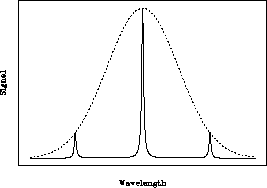Leakage





Next: Tracking Noise
Up: Fabry-Pérot Section
Previous: Saturation
The Fabry-Pérot section uses the grating as an order sorter that suppresses
unwanted F-P orders. This suppression is not complete for part of the SWS
wavelength range. Neighbouring F-P orders are `leaking' through the wings
of the grating instrumental profile, contributing significantly to the
total measured signal (See Fig.  ) .
For observations of a single line
superposed on a smooth continuum, the only drawback of leakage is a
more complicated flux calibration, since leakage will increase the
observed continuum but not the line. More serious effects occur
in crowded spectra, where strong lines seen in the `wrong' F-P order may
significantly distort the observed spectrum, requiring observations
of wider wavelength ranges in order to determine the severity of this effect
and `clean' the spectrum (See Fig.
) .
For observations of a single line
superposed on a smooth continuum, the only drawback of leakage is a
more complicated flux calibration, since leakage will increase the
observed continuum but not the line. More serious effects occur
in crowded spectra, where strong lines seen in the `wrong' F-P order may
significantly distort the observed spectrum, requiring observations
of wider wavelength ranges in order to determine the severity of this effect
and `clean' the spectrum (See Fig.  ).
).
Leakage has been quantified
by analysis of the grating instrumental profile as seen by the F-P detectors
in scans of solid state laser lines.
Fig.  shows the leakage as a function of wavelength.
It must be considered preliminary, since it is based on extrapolating the
grating instrumental profile from
measurements only at a few wavelengths of laser lines. The grating
instrumental profile will be characterized in more detail in orbit.
shows the leakage as a function of wavelength.
It must be considered preliminary, since it is based on extrapolating the
grating instrumental profile from
measurements only at a few wavelengths of laser lines. The grating
instrumental profile will be characterized in more detail in orbit.
The spectral response data in section 5.2.2 have not been corrected for the
effects of leakage, i.e. they refer to the total signal.

Figure: Basics of leakage in F-P spectra. The instrumental profile of
the combination of F-P and grating is given by the solid line. Residual
transmission from neighbouring F-P orders occurs if the instrumental
profile of the grating alone (dashed line) is too wide
SWS Consortium
Tue Jul 30 15:56:20 MET DST 1996
 ) .
For observations of a single line
superposed on a smooth continuum, the only drawback of leakage is a
more complicated flux calibration, since leakage will increase the
observed continuum but not the line. More serious effects occur
in crowded spectra, where strong lines seen in the `wrong' F-P order may
significantly distort the observed spectrum, requiring observations
of wider wavelength ranges in order to determine the severity of this effect
and `clean' the spectrum (See Fig.
) .
For observations of a single line
superposed on a smooth continuum, the only drawback of leakage is a
more complicated flux calibration, since leakage will increase the
observed continuum but not the line. More serious effects occur
in crowded spectra, where strong lines seen in the `wrong' F-P order may
significantly distort the observed spectrum, requiring observations
of wider wavelength ranges in order to determine the severity of this effect
and `clean' the spectrum (See Fig.  ).
).





